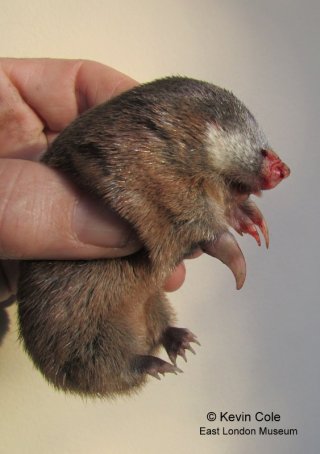There are 15 species of golden moles in southern Africa. Endemic to Africa (south of the Sahara), these small mammals are all similiar in appearance with no external ears, no visible eyes and no external tails. They all have sheens of various colours on their fur and a head which is pointed with a horny pad on the muzzle which encloses the nostrils.
The specimen picture below was scuffed out of its burrow by a domestic dog in Beacon Bay (East London) and saved to live another day. The size of approxiamately 120mm and the distinct patches of off-white hair covering the minute ear openings allude to the specie being a Hottentot golden mole Amblysomus hottentotus.

Amblysomus hottentotus – note the 3rd claw, which is the largest having a thick leading edge and a knife-like trailing edge. Also note the horny pad on the point of the muzzle
These moles use sub-surface runs of 4-6 centimeters below the ground surface and burrow up to a half a meter deep. The run and burrow system may extend to over 200m in length. Hottentot golden moles, unlike some other golden moles, will not only eat insects and earthworms but also snails and vegetable matter. Most of their moisture requirements are obtained from their food or dew.
The other specie of golden mole that may be found in the East London area is the Zulu golden mole Amblysomus iris. This mole is smaller than the Hottentot golden mole – it measures roughly 100 mm and the upper parts are very dark smoky-brown with a greenish sheen.
Reference: The Mammals of the southern African Subregion by JD Skinner and RHN Smithers (1990).
